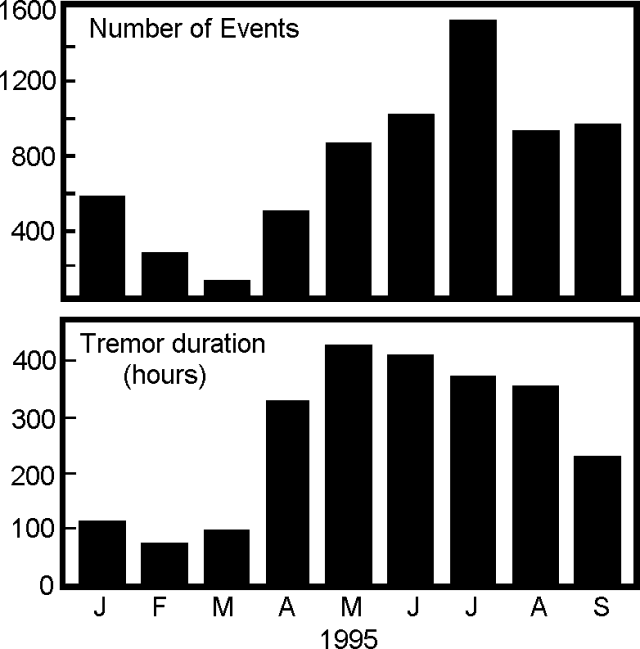Report on Arenal (Costa Rica) — September 1995
Bulletin of the Global Volcanism Network, vol. 20, no. 9 (September 1995)
Managing Editor: Richard Wunderman.
Arenal (Costa Rica) Gas and lava emissions; some Strombolian eruptions and pyroclastic flows
Please cite this report as:
Global Volcanism Program, 1995. Report on Arenal (Costa Rica) (Wunderman, R., ed.). Bulletin of the Global Volcanism Network, 20:9. Smithsonian Institution. https://doi.org/10.5479/si.GVP.BGVN199509-345033
Arenal
Costa Rica
10.463°N, 84.703°W; summit elev. 1670 m
All times are local (unless otherwise noted)
In September, Arenal's active vent, crater C, continued its regular emission of gases, lava, and sporadic Strombolian eruptions; in addition, there were occasional pyroclastic flows. Lava that began to be emitted in July 1995 followed a course toward the SW and by the end of September had flowed to 1,050-m elevation. By the end of September, lava moving NW reached 800 m elevation. At the 1,400-m elevation a new arm branched off; it trended SW and by the end of September had reached 1,200 m elevation.
Explosions in September sent columns >1 km above the active vent that were typically blown to the NW, W, and SW. Toward the end of the month, some ash also fell on the NE and E flanks. Bombs and blocks arrived at elevations as low as 1,200 m. Crater D was fumarolically active.
During September there were 977 seismic events and 223 hours of tremor (figure 73). The majority of the seismic events were associated with Strombolian eruptions. Some of these eruptions were large enough to register at an outlying station 27 km more distant from Arenal than the one usually used (station JTS, 30 km SW of the crater). The total number of events (figure 73) for February and March were extrapolated based on 9 and 19 days, respectively, of recorded data.
 |
Figure 73. Seismic events and tremor at Arenal, January-September 1995, recorded at Station VACR (2.7 km NE of the main crater). Courtesy of OVSICORI-UNA. |
A pulse of expansion detected in May 1995 ceased, and in September distance lines returned to a tendency toward long-term contraction (13 µrad/year). With the exception of one dry tilt instrument, which indicated deflation at 12 µrad/year on the W flank, there were no significant measured changes in tilt.
A brilliant color photograph of Arenal erupting appeared on the front page of the Washington Times on 22 September. Without either objects for scale or accompanying clarifying text, the photo caused considerable short-term confusion about the volcano's status. It was quickly learned that the photo depicted typical conditions at the volcano and observers in Costa Rica had not witnessed increases in activity. The volcano's first chronicled eruption took place in 1968 and many basaltic andesite discharges have followed.
Geological Summary. Conical Volcán Arenal is the youngest stratovolcano in Costa Rica and one of its most active. The 1670-m-high andesitic volcano towers above the eastern shores of Lake Arenal, which has been enlarged by a hydroelectric project. Arenal lies along a volcanic chain that has migrated to the NW from the late-Pleistocene Los Perdidos lava domes through the Pleistocene-to-Holocene Chato volcano, which contains a 500-m-wide, lake-filled summit crater. The earliest known eruptions of Arenal took place about 7000 years ago, and it was active concurrently with Cerro Chato until the activity of Chato ended about 3500 years ago. Growth of Arenal has been characterized by periodic major explosive eruptions at several-hundred-year intervals and periods of lava effusion that armor the cone. An eruptive period that began with a major explosive eruption in 1968 ended in December 2010; continuous explosive activity accompanied by slow lava effusion and the occasional emission of pyroclastic flows characterized the eruption from vents at the summit and on the upper western flank.
Information Contacts: E. Fernandez, E. Duarte, R. Saenz, W. Jimenez, and V. Barboza, Observatorio Vulcanologico y Sismologico de Costa Rica, Universidad Nacional (OVSICORI-UNA), Apartado 86-3000, Heredia, Costa Rica.

